By setting out policy and spending charities, charities could find comfort in favourable returns for multi-asset investors
________________________________________________________________
In the last few years, investors have been confronted with one of the most aggressive bouts of inflation seen in decades. While there has been a strong recovery in portfolio values over the last year, questions remain as to what the future holds for charity investors.
We believe it is important to consider:
1. The past – how have portfolios historically behaved in these market environments?
2. The future – what do we expect to drive returns going forward?
3. Today’s portfolio – what are the implications of our forecasts for asset allocation?
All data in this article are sourced from The Compendium of Investment, 2024 edition, Sarasin & Partners. Every two years we update the data in the Sarasin Compendium of Investment and set out our projections for returns from core asset classes over the next 7-10 years.
History favours the patient
With the support of our data providers, we have produced what we believe is the longest track record for a charity portfolio, the Endowment Model. Our analysis traces all the way back to 1900, reminding us of the many periods of growth, collapse and recovery, that an investor would have experienced in the last 124 years.
Given the surge in inflation experienced during 2021-23, we have specifically reviewed how our multiasset approach has performed following periods when inflation outpaced the absolute return, resulting in negative real returns. The results make for heartening reading, showing a general trend of rebounds in performance.
Following a period of negative real returns, investors in the Endowment Model experienced average real returns of 5.6% per annum over the next five years. However, particularly sharp losses – where real returns have declined by more than 10% in any one year – have typically been followed by even stronger real returns of 6.6% per annum over the next five years.
Perhaps the key insight from our analysis is that the worst decision for many investors would have been to sell in the depths of a market decline and then miss out on the recovery. If history serves as a guide, investors in multi-asset strategies are likely to experience a rebound in returns, as has already been seen in 2023 and so far this year.
The fundamentals that drive projected returns
While the past offers helpful lessons, the key driver of our market projections is the prevailing economic environment and how we expect it to shape investment markets.
Over the long term, returns from equities are driven by the rate at which capital is returned to shareholders (via dividends and buybacks). Over the near term, gross domestic product (GDP) is expected to grow a little quicker as inflation begins to recede, and interest rates are lowered. Growth declines gradually thereafter, as the working-age population grows at a slower rate. This, together with a range of other factors detailed in the Compendium of Investment, sets the tone for 7-10 year expected returns.
These returns are lower than the historical average since 1900, as UK equities and gilts have typically generated 9.0% per annum and 5.0% per annum, respectively.
However, we are also expecting inflation to be lower – on average 2.3% per annum, while the average since 1900 has been 3.8%. This is positive for the spending power of charities.
What are the implications for today’s portfolios?
To help charities understand the impacts of our forecasts on both their medium-term and long-term portfolios, we have used the following:
• Reserves Model – medium-term time horizon (2-4 years). Predominantly invested in UK gilts and corporate bonds, with the balance allocated to equities and alternatives.
• Endowment Model – long-term time horizon (5+ years). Predominantly invested in equities, with the balance allocated to bonds, alternatives and property.
Given the more conservative asset allocation and the expectation of bonds generating a lower return than equities, our Reserves Model is projected to earn a return of 5.2% per annum, or 2.8% after inflation. This is materially higher than one might have expected from such a portfolio a few years ago, largely because higher interest rates have boosted potential returns from bonds.
The Endowment Model, which has a higher exposure to equities, is forecasted to generate a return of 7.0% per annum, or 4.6% after inflation. Interestingly, this is in line with the long-run real returns generated since 1900 of 4.4%. The higher projected return available from equities may tempt investors towards the Endowment Model. However, it is crucial to understand your time horizon and that equities are typically more volatile than bonds.
What could materially change our outlook?
Forecasting the global economy 10 years from here is complex, as is assessing the implications for multiasset investment returns. Two key considerations are the rapid advances in technology and the transition to net zero, both of which could have major implications for productivity.
The effect of technology on productivity growth is hard to predict. Technological change can be sporadic, rapid and disruptive – as well as a significant investment opportunity.
Real improvement comes when a technological breakthrough allows an economy to overcome increases in costs, and achieve higher production levels than before the cost pressure occurred.
The rapid development of generative artificial intelligence (AI) may prove to be an example of this. And despite adding to inflationary pressures and social and political strife, climate change and the transition to net zero economies could be another.
Summary
In setting out policy and spending decisions, charities may find comfort that the current economic and market environment suggests healthy returns for multi-asset investors. With a projected real return of 4.6% per annum from the Endowment Model, trustees can ensure that they are able to adequately support the needs of today’s stakeholders, while preserving the real capital value for future trustees and longer-term needs.
The returns we cite here and in the Compendium are the average annual returns that investors could achieve over the next 7-10 years, rather than in any single year. Our projections are also base-case ‘index’ returns. Active investment management could add or detract from them, and the effect of investment management fees and other costs must also be taken into account.
Disclaimer: This document is intended for retail investors and/or charities. You should not act or rely on this document but should contact your professional adviser. The value of your investments and any income derived from them can fall as well as rise and you may not get back the amount originally invested.
Latest News
-
Government launches £85m arts and culture fund
-
Regulator updates charity cash collection advice for retailers
-
Housing Association offers £5,000 grants to charities to mark 125th anniversary
-
HIV charities cut services and plunder reserves amid ‘severe funding crisis’
-
Philanthropist’s foundation pledges £100m to good causes over next five years
-
Redundancies at hospice charity amid rising costs and falling donations
Charity Times video Q&A: In conversation with Hilda Hayo, CEO of Dementia UK
Charity Times editor, Lauren Weymouth, is joined by Dementia UK CEO, Hilda Hayo to discuss why the charity receives such high workplace satisfaction results, what a positive working culture looks like and the importance of lived experience among staff. The pair talk about challenges facing the charity, the impact felt by the pandemic and how it's striving to overcome obstacles and continue to be a highly impactful organisation for anybody affected by dementia.
Charity Times Awards 2023
Mitigating risk and reducing claims

The cost-of-living crisis is impacting charities in a number of ways, including the risks they take. Endsleigh Insurance’s* senior risk management consultant Scott Crichton joins Charity Times to discuss the ramifications of prioritising certain types of risk over others, the financial implications risk can have if not managed properly, and tips for charities to help manage those risks.
* Coming soon… Howden, the new name for Endsleigh.
* Coming soon… Howden, the new name for Endsleigh.
Better Society

© 2021 Perspective Publishing Privacy & Cookies










Recent Stories